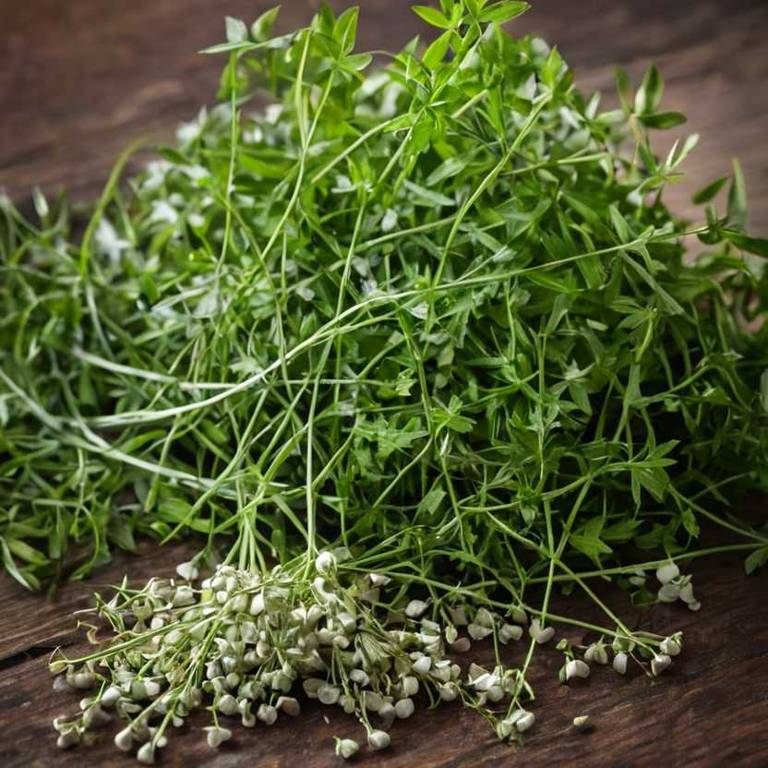Sweet Woodruff (Galium Odoratum)
Information Reliability Score: 5/10
This score reflects the overall reliability of the information presented in this article. It is based on the quality of scientific evidence, accuracy of sources, and the transparency of references related to Galium odoratum.
 Sweet Woodruff, scientifically known as Galium odoratum, is a perennial herb native to Europe and parts of Asia, prized for its medicinal and aromatic properties. It is commonly used as a medicinal herb and adaptogen, known for its soothing effects on the nervous system and its ability to support overall well-being. Traditionally, it has been used in European folklore and herbal medicine to treat ailments such as insomnia, nervous tension, and digestive issues, with its mild, hay-like fragrance believed to have calming properties. In modern wellness practices, it is often incorporated into teas, tinctures, and aromatherapy blends to promote relaxation and stress relief. One of its unique features is the presence of a rare compound called coumarin, which gives it a distinctive flavor and has been historically used in the production of perfumes and as a natural sweetener.
Sweet Woodruff, scientifically known as Galium odoratum, is a perennial herb native to Europe and parts of Asia, prized for its medicinal and aromatic properties. It is commonly used as a medicinal herb and adaptogen, known for its soothing effects on the nervous system and its ability to support overall well-being. Traditionally, it has been used in European folklore and herbal medicine to treat ailments such as insomnia, nervous tension, and digestive issues, with its mild, hay-like fragrance believed to have calming properties. In modern wellness practices, it is often incorporated into teas, tinctures, and aromatherapy blends to promote relaxation and stress relief. One of its unique features is the presence of a rare compound called coumarin, which gives it a distinctive flavor and has been historically used in the production of perfumes and as a natural sweetener.
FREE CHECKLIST
The Only 10 Herbs You Need to Heal 90% of Common Ailments.

Table of Contents
Scientific and Botanical Profile
Sweet Woodruff, with botanical name Galium odoratum, is a perennial herbaceous plant belonging to the family Rubiaceae. Native to regions such as Europe, Asia, Southwest Europe, North Africa, the Middle East, the Alps, the Pyrenees, Central Europe, Scandinavia, and the Balkans, it is commonly known by various names including Common Woodruff, Woolly Woodruff, Sweet Bedstraw, and Galium Sweet. Morphologically, it features slender, creeping stems that often climb or trail along the ground, with opposite, heart-shaped leaves that are hairy and emit a sweet, vanilla-like aroma when crushed. The plant produces small, white, five-petaled flowers that bloom in clusters, typically in early summer, and is also known by folk names such as Sweet Aleurone, Gallant Soldier, Climbing Wood Sorrel, Lamb's-Qarters, and Sweet William.History and Cultural Relevance
Sweet Woodruff was used by ancient civilizations such as the Romans and the Greeks for its aromatic properties and medicinal benefits, often incorporating it into baths and perfumes to promote relaxation and treat skin ailments. In medieval Europe, it was highly valued in folk medicine for its purported ability to ward off insects and was commonly used to treat ailments like headaches, fevers, and digestive issues. The plant also held cultural significance in various traditions, including being used in wedding ceremonies and as a symbol of fertility and renewal, with its fragrant blossoms often incorporated into floral arrangements and rituals. Today, its extracts are still used in herbal remedies for their mild sedative effects and as a natural remedy for insomnia and anxiety, reflecting its enduring legacy in traditional healing practices. Its historical and cultural importance continues to inspire modern applications in aromatherapy and holistic wellness.Chemical Composition and Nutritional Profile
Sweet Woodruff contains a variety of bioactive compounds, including flavonoids such as rutin and quercetin, which are known for their antioxidant and anti-inflammatory properties. It also contains essential oils rich in compounds like methyl eugenol and coumarin, which contribute to its distinctive aroma and potential therapeutic effects. The plant is a good source of vitamins, particularly vitamin C and certain B-complex vitamins, as well as minerals like calcium and iron. Its antioxidant profile helps neutralize free radicals, supporting immune function and cellular health. Mechanistically, the flavonoids and essential oils in Sweet Woodruff may interact with biological systems to reduce oxidative stress and modulate inflammatory responses in the body.Medicinal Properties and Health Benefits
Galium odoratum has been traditionally used for its calming and healing properties, primarily targeting the nervous and respiratory systems. It is known to help reduce anxiety and promote relaxation, making it beneficial for individuals suffering from stress-related disorders. Its anti-inflammatory and antispasmodic qualities also support digestive health by alleviating symptoms of indigestion and bloating. Compared to similar herbs like valerian or passionflower, galium odoratum offers a more subtle and long-lasting calming effect without the sedative intensity of valerian, making it a gentler option for daily use. Additionally, its unique combination of mild sedative and digestive benefits sets it apart, offering a versatile natural remedy for both mental and physical well-being.Discover the 10 best health benefits of Sweet Woodruff.